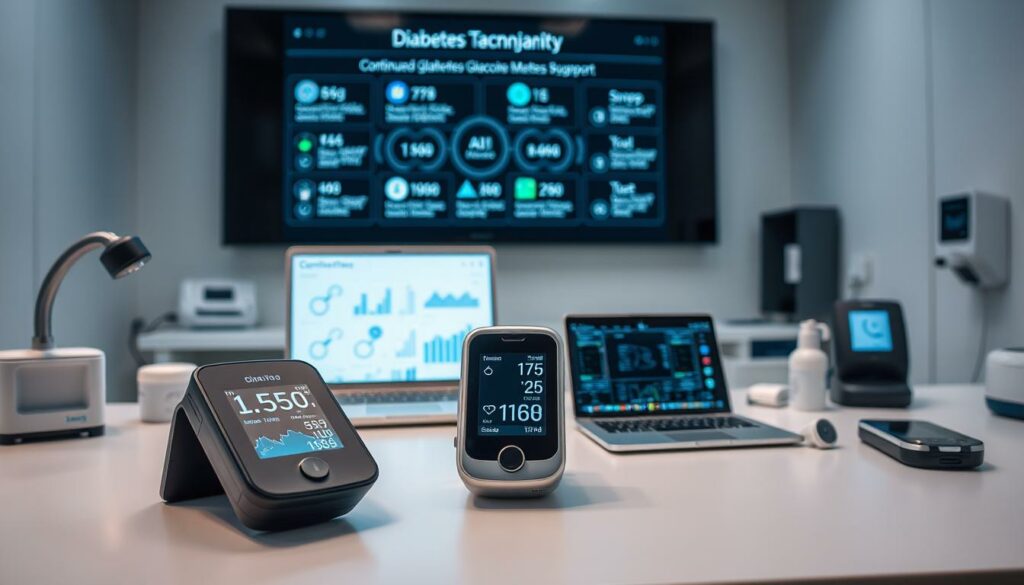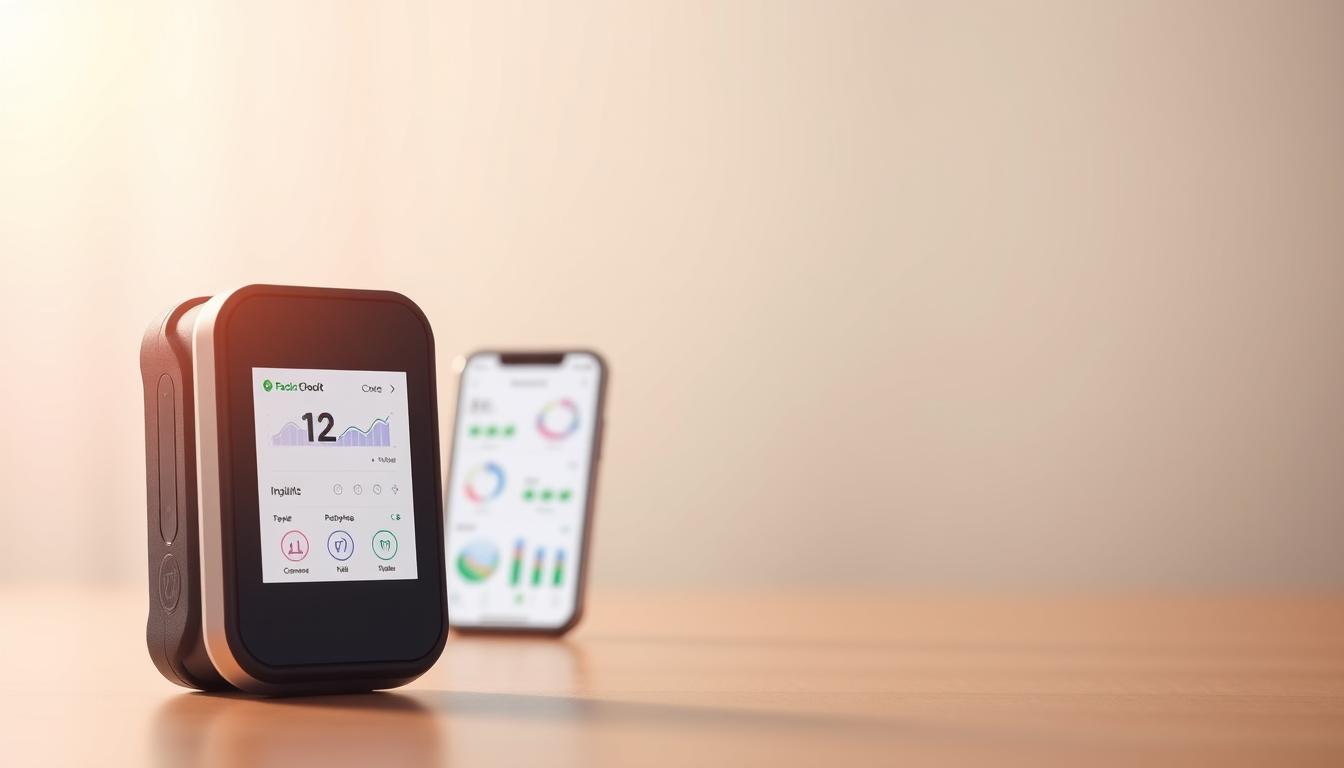Managing diabetes well is key to staying healthy and avoiding serious problems. Thanks to new tech, you can now use AI in diabetes management to keep an eye on your health from home.
Diabetes care at home has gotten a lot better. Now, you can track your blood sugar, meds, and how you live more easily. AI tools give you advice that fits your needs, helping you make smart health choices.
Key Takeaways
- AI enhances diabetes management by providing personalized care.
- Effective diabetes care at home involves monitoring glucose levels and lifestyle choices.
- AI-driven tools offer tailored insights for better health decisions.
- Managing diabetes from home is now more efficient and accurate.
- AI technology supports proactive diabetes care.
The Current Landscape of Diabetes Management
The way we manage diabetes is changing fast with new technologies. Before, managing diabetes was hard work that needed a lot of manual effort.
Traditional Diabetes Management Approaches
Old ways to manage diabetes include testing blood sugar and using insulin.
Manual Blood Glucose Testing
Testing blood sugar manually means using a glucometer. People have to prick their fingers many times a day. This can hurt and is hard to do. Manual testing also has its downsides, like mistakes and no real-time data.
Standard Insulin Administration
Injecting insulin with syringes or pens is common. It works but can be tricky and might cause mistakes if not done right. Getting the right amount of insulin is key to keeping blood sugar in check.
Challenges of Managing Diabetes Remotely
Dealing with diabetes at home can be tough without a doctor nearby. It’s hard to keep track of your health, which can lead to serious problems. Not having constant monitoring and help can make managing diabetes harder.
- It’s hard to keep blood sugar levels steady
- It’s hard to get help from doctors right away
- There’s a higher chance of diabetes-related problems
The Need for Technological Intervention
The old ways of managing diabetes aren’t working well anymore.
“New technology in diabetes care could change how we manage it, making it better and easier.”
New tools like continuous glucose monitors and AI can help fix the problems of old methods. They offer a more detailed and personal way to manage diabetes.

Understanding How AI Is Helping People Manage Diabetes from Home
AI is changing how we manage diabetes, making treatment easier. It has brought big changes to healthcare, helping with diabetes care.
The Evolution of AI in Healthcare
AI has changed how we handle chronic diseases like diabetes. Machine learning algorithms and predictive analytics help give care that fits each person.
Core AI Technologies Transforming Diabetes Care
Many AI technologies are improving diabetes care. These include:
- Machine Learning Algorithms: They help predict glucose levels and create treatment plans.
- Natural Language Processing: It makes talking between patients and doctors easier.
- Computer Vision: It helps analyze medical images and data.

Machine learning algorithms look at patient data to forecast glucose levels. They also offer tips on managing diabetes well.
Natural Language Processing
NLP helps create chatbots and virtual assistants. These tools help patients manage their diabetes better.
Computer Vision
Computer vision looks at medical images, like retinal scans. It spots problems early.
The Intersection of AI and Telemedicine
AI and telemedicine together have changed remote diabetes care. AI-powered glucose monitoring and telemedicine let doctors give ongoing care.
Getting Started with AI-Powered Glucose Monitoring Systems
AI-driven continuous glucose monitoring is changing how we manage diabetes.
Selecting the Right Continuous Glucose Monitoring (CGM) System
Choosing the right CGM system is key for managing diabetes well. Look at accuracy, ease of use, and device compatibility when picking a CGM.
Comparing Popular AI-Enhanced CGM Options
There are many AI-enhanced CGM systems out there. Some offer advanced predictive analytics. Others work well with insulin pumps and pens.
- Dexcom G6: Known for its accuracy and predictive alerts.
- Medtronic Guardian Connect: Offers advanced predictive analytics.
- Freestyle Libre 2: Features optional alarms for high or low glucose levels.
Setup and Calibration Steps
Setting up your CGM takes a few steps. You need to insert the sensor, calibrate it, and set up alert settings. Always follow the manufacturer’s instructions for best results.
- Insert the sensor as directed.
- Calibrate the device according to the manufacturer’s guidelines.
- Configure alert settings for high or low glucose levels.
Connecting Smart Insulin Pens and Pumps
Connecting your CGM with smart insulin pens and pumps can improve your diabetes care. This connection helps with more precise insulin dosing and better glucose control.
Benefits of Integration:
- Improved glucose control.
- More accurate insulin dosing.
- Enhanced data insights for better decision-making.
How to Interpret and Act on AI-Generated Glucose Data
AI-generated data offers valuable insights into your glucose trends. Understanding this data is essential for making informed decisions.
Understanding Pattern Recognition
AI algorithms can spot patterns in your glucose data. This helps you anticipate and prevent glucose excursions.
“AI-driven pattern recognition has revolutionized my ability to manage diabetes.”
Responding to Predictive Alerts
Predictive alerts from your CGM can warn you of high or low glucose levels. Acting quickly on these alerts can prevent serious issues.
For example, if your CGM predicts a low glucose level, eating a quick-acting carbohydrate can prevent hypoglycemia.
Leveraging AI for Personalized Nutrition Management
Managing diabetes gets better with AI-driven nutrition planning. AI helps give you diet plans that fit your needs. This way, you can make better food choices.
Setting Up AI-Driven Food Recognition Apps
Start with AI-driven food recognition apps. These apps show what’s in your meals. It’s easier to keep track of your diet this way.
Step-by-Step Configuration Guide
Setting up these apps is easy. First, download and install the app. Then, make an account or log in if you already have one. Follow the app’s instructions to teach the AI about your meals.
Training the AI to Recognize Your Common Foods
To make your food app better, train it on your usual foods. Log your meals and correct the app’s guesses. Over time, it will guess your meals right more often.
Using Meal Planning Applications with Machine Learning
Meal planning apps with machine learning are great too. They make meal plans just for you. They consider your diet, likes, and health goals.
Practical Steps to Optimize Your Diet Using AI Tools
To improve your diet, understand what AI tools suggest. Look at the macronutrients and serving sizes they give. Adjust these to fit your taste and needs.
Interpreting Nutritional Recommendations
When using AI for nutrition, focus on the macronutrients and serving sizes. Make these fit your personal diet and preferences.
Fine-tuning AI Suggestions Based on Personal Response
See how your body reacts to AI diet plans. If they help, keep going. If not, tell the AI to adjust.
Here’s a comparison of popular AI-driven nutrition planning tools:
| Tool | Key Features | User Feedback |
|---|---|---|
| MyFitnessPal | Large database, barcode scanner, meal planning | 8/10 |
| PlateJoy | Personalized meal plans, grocery lists | 9/10 |
| Fooducate | Nutritional insights, meal planning, fitness tracking | 8.5/10 |
Implementing AI Applications for Medication Management
AI is changing how we manage diabetes medication. It helps patients stick to their treatment plans better. This leads to better health outcomes.
Configuring Smart Medication Reminders and Tracking
Smart reminders and tracking are key for diabetes medication. AI tools send reminders tailored to each patient. This ensures they take their meds on time.
Setting Up Personalized Alert Systems
AI apps can set up alerts that fit your schedule. Personalized alerts make reminders more effective. They’re tailored to your needs.
Tracking Medication Effectiveness
AI tracks how well diabetes meds work. It gives insights into treatment success. This helps in making better treatment choices.
Utilizing Predictive Analytics for Medication Adjustments
Predictive analytics are vital in diabetes care. They help doctors adjust meds based on data. AI predicts complications and suggests prevention.
Troubleshooting Common AI Medication Assistant Issues
AI medication assistants have many benefits. But, they can face issues like data errors and compatibility problems. Fixing these issues quickly is key to their success.
A study found AI in diabetes management is promising. It improves patient outcomes.
“AI-powered systems can analyze complex data sets to identify patterns and predict patient needs, enabling proactive care.”
Creating Your AI-Powered Exercise Routine
Now, you can make your own exercise plan with AI. It’s tailored to your diabetes needs. This makes your workouts better, safer, and more fun.
Configuring AI-Powered Exercise Recommendations
To start, set up the AI with your health info and what you like. Tell it your fitness goals, any limits, and health numbers.
Key considerations: Think about your age, fitness level, and diabetes when setting up the AI.
Connecting Activity Trackers with Glucose Monitoring
Link your activity trackers with glucose monitors for better AI advice. This lets the AI give you more precise tips.
Compatible Devices and Setup Instructions
Make sure your devices work with the AI. Follow the setup guide, usually via Bluetooth or Wi-Fi.
After linking, the AI will match your activity with glucose levels. This helps you make smart exercise choices.
For example, you might see some exercises lower your blood sugar more. This lets you tweak your routine.
Developing a Personalized AI Exercise Plan
With your data in, the AI makes a plan just for you. It considers your fitness, goals, and how you react to exercise.
Adjusting Workouts Based on AI Feedback
The AI will keep giving you feedback as you work out. Use this to tweak your routine for the best results.
Safety Considerations and Precautions
AI exercise plans are mostly safe, but watch out for risks like too much exercise or low blood sugar. Always talk to a doctor before starting a new workout plan.
“Exercise is key for diabetes care, and AI helps us customize plans for each person,” says Dr. Jane Smith, a top diabetes expert.
Setting Up Predictive Analytics to Prevent Complications
AI-driven predictive analytics can greatly lower the risk of diabetes complications. It uses past data and algorithms to predict future issues. This helps prevent diabetes problems before they start.
How to Enable AI Pattern Identification
To start using AI for pattern recognition, you need to set up the right data sources and adjust some parameters. Here’s how:
Configuring Data Sources
Make sure your CGM system, smart insulin pens, and other health devices are linked to your AI platform. This lets you analyze all your health data together.
Setting Threshold Parameters
Change the threshold parameters based on what your healthcare provider suggests. These settings tell the AI when to warn you about possible problems.
Establishing Early Warning Systems
Early warning systems are key to avoiding diabetes complications. They send you alerts about health risks early. This lets you act fast to prevent big problems.
| Feature | Description | Benefit |
|---|---|---|
| Real-time Alerts | Get instant messages about changes in your glucose levels. | Quick action to stop severe low or high blood sugar. |
| Predictive Insights | AI analyzes your data to predict future glucose levels. | Make changes to your diet, exercise, or meds early. |
| Personalized Recommendations | Get advice that fits your health data and goals. | Manage your diabetes better with a plan that’s just for you. |
Creating an Action Plan for AI-Generated Alerts
When you get an alert from AI, it’s important to know what to do. Here’s what to do:
Emergency Response Protocols
For serious alerts, like a high risk of low or high blood sugar, have a plan. This might mean calling your doctor or getting help right away.
Non-Emergency Adjustments
For alerts that aren’t as urgent, make changes to your diet, exercise, or meds as suggested by AI. Always check with your doctor to make sure these changes work well for you.
Coordinating AI Diabetes Management with Your Healthcare Team
AI can change how we manage diabetes, but working with your healthcare team is key. Using AI tools for diabetes care means you need to team up with your healthcare team. This teamwork is vital for full care.
Preparing and Sharing AI-Generated Reports
To work well with your healthcare team, you must share AI reports. Here’s how:
- Exporting and Formatting Data: Make sure your AI data is easy for your healthcare providers to read.
- Highlighting Key Insights: Use AI data to show important trends that help with your diabetes plan.
Implementing Collaborative Care Models Using AI
AI can make your diabetes care better by working with your healthcare team. Sharing AI insights helps adjust your care plan as needed.
Maximizing Telehealth Appointments with AI Insights
Telehealth is getting more important, and AI helps make these appointments better.
Pre-Appointment Preparation
Before your telehealth visit, use AI to summarize your diabetes status. Include any recent changes or concerns.
Effective Communication of AI-Generated Data
At the appointment, share the insights and advice from your AI tools with your healthcare provider.
By combining AI with your healthcare team’s knowledge, you get a better care plan. Experts say,
“The integration of AI in diabetes care is not just about technology; it’s about improving care through better data-driven decisions.”
Addressing Privacy Concerns and Overcoming Technical Challenges
Using AI in diabetes care has many benefits. But, it’s important to think about privacy and technical issues. Your health data needs to be safe and used wisely.
Securing Your Health Data in AI Applications
To keep your health info safe, know how AI tools handle your data. Setting privacy options right is key to avoiding misuse.
Privacy Settings Configuration
Check your AI diabetes tools’ privacy settings often. Make sure you only share data that’s needed for your care.
Understanding Data Sharing Policies
Know how your data is shared. See if it goes to other services or is used for research. Being open about data use helps you control your health info.
Solutions for Limited Technical Access or Knowledge
Not everyone can use technology or know how to. Getting help from healthcare or digital programs can help a lot.
Evaluating the Reliability of AI Recommendations
AI can offer great insights, but check if its advice is reliable. Knowing why AI suggests something helps you make better choices.
Verification Strategies
Compare AI advice with medical guidelines or talk to your doctor. This helps confirm the suggestions.
When to Trust vs. When to Question
Decide when to trust AI and when to ask for a second opinion. Using your own judgment is important.
| Challenge | Solution | Benefit |
|---|---|---|
| Data Privacy Concerns | Configure privacy settings, understand data sharing policies | Enhanced security and control over personal health data |
| Limited Technical Access | Seek support from healthcare providers or digital literacy programs | Better ability to utilize AI tools effectively |
| Reliability of AI Recommendations | Verify AI suggestions with clinical guidelines or healthcare providers | More informed decision-making regarding diabetes management |
By tackling these issues, you can use AI better for diabetes care. This makes your care more secure, accessible, and reliable.
Conclusion: Embracing the Future of AI-Powered Diabetes Care
AI is changing how we manage diabetes. It makes glucose monitoring easier and helps plan meals and exercise. This way, you can avoid future health problems.
AI tools like continuous glucose monitors and smart insulin pens make treatment simpler. They offer personalized advice on what to eat and how to stay active. This is a big step towards better diabetes care.
By using AI and working with your healthcare team, you can manage your diabetes better. This approach improves your health and life quality. As AI gets better, you’ll see even more ways to manage diabetes effectively.


